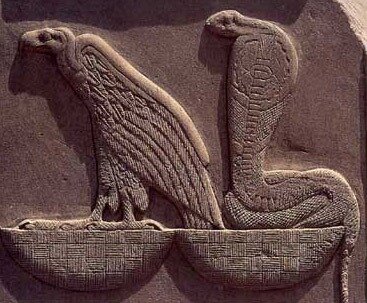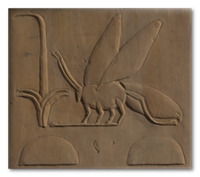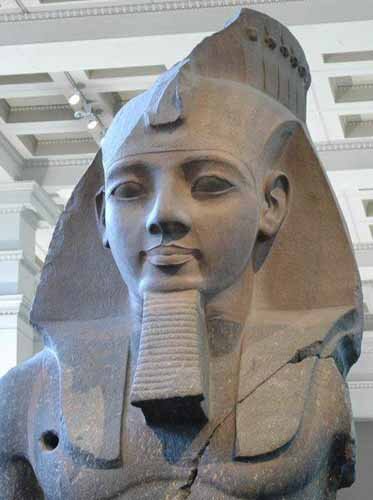The Sunday Section: Ancient Egypt - Royal Titles
Apologies for the unintended break … Continuing on from ‘Language’, I thought it would be interesting to have a look at names for royalty in Ancient Egypt.
The kings of Ancient Egypt are commonly referred to as ‘pharaohs’. The word derived from ‘pr-aa’, which referred to the buildings of the palace or court.
‘pr-aa’
From the 12th Dynasty, from about 2000BC, the word appeared as part of a wish formula, ‘ Great House, may it live, prosper, and be in health’, but still only referenced the royal palace, not the person.
It was during the reign of Thutmose III (around 1479-1425BC) that ‘pharaoh’ became the form of address for he who was king. The earliest recorded instance where ‘ pr-aa’ is used to address the ruler, is in a letter to Amenhotep IV (about 1353-1336BC), which was addressed to ‘ Pharaoh, all life, prosperity and health!’
From the latter half of the 5th Dynasty, the ‘Old Kingdom’, which dates roughly from 2494-2345BC, royal titles consisted of 5 titles, or ‘great names’, with each title having a specific meaning.
The HORUS-NAME, the oldest part, also referred to as the ‘banner-name’ or the ‘Ka-name’ (I’ll be talking about ‘ka’ in a later post), symbolises the king as the earthly embodiment of the god, Horus, the patron of the kings of Egypt, thus emphasising the king’s divinity.
Tombstone of Djet, with Horus name (Wikiwand)
The design of recessed panelling under the name is still known by its Ancient Egyptian name, ‘ serekh’, which basically means ‘façade’, and refers to an ornamental decoration which imitated the floorplan of a palace façade. Above the ‘ serekh’ is usually found the falcon of Horus.
The Horus-name, given to the king when he ascended the throne, was his official name. This was the name that appeared in official documents, not his birth name, which had nothing to do with the Horus-name.
The NEBTI-NAME, shows the king in a special relation to 2 goddesses who are the deified personification of Upper and Lower Egypt – Nekhbet, the vulture-goddess of the Upper Egyptian cities of Elkab and Hierakonpolis; and Uto, the cobra-goddess of the Lower Egyptian city, Buto. The Nebti-name denotes the king as “ the one of Nekhbet and Uto”, showing that he belongs to Upper and Lower Egypt.
Nebti-name - Nekhbet, vulture-goddess and Uto, cobra-goddess
The third title, the GOLDEN HORUS-NAME, represents Horus, the falcon god, perched on a symbol that usually represents ‘gold’.
Golden Horus-name
An inscription of the 12th Dynasty (part of the ‘Middle Kingdom’, from about 2000BC) describes the Golden Horus-name as the ‘name of gold’. Gold was strongly linked to the idea of ‘eternity’. In the ‘New Kingdom’ (which began about 1570BC), the burial chamber in the royal tombs was often referred to as ‘the golden room’. Apart from the fact that it was crammed full of gold objects, it was believed that it would be there for eternity. Similarly, the Golden Horus-name may have had the same connotation, with the belief that the king may be an eternal Horus.
The PRENOMEN is also known as the ‘throne-name’ and the ‘Niswt-bity name’.
The ‘throne-name’; the ‘Niswt-bity name’
‘Niswt’ symbolised Upper Egypt, and is made of the hieroglyphic signs of a four-leafed sedge over a bread loaf; probably chosen because the sedge was seen as a symbol for fertility and harvest.
‘Bity’ is comprised of the sign for a honey bee over a bread loaf, and symbolised Lower Egypt. Several reasons have been put forward as to why the Ancient Egyptians chose the symbol of the bee – honey was an important source of food and medicine; it was vital for trade; in building their hives, bees observed a strict social structure, which was important to the Egyptians; the bee’s sting reflected the king’s ability to defend his realm.
The least understood of the 5 titles, today it is usually translated as ‘King of Upper and Lower Egypt’, but in Ancient Egypt was more likely read as ‘ he of the sedge and the bee’, referring to the king as ‘the dual king’. This duality was based on the premise that, as the king ruled the 2 lands of Upper and Lower Egypt, so he ruled over anything that had, both, contradictory and complementary meanings, for example, ‘good/evil’, and ‘light/darkness’.
The NOMEN was added in the beginning of the 4th Dynasty (2613-2494BC). It was the king’s birth name, and is introduced by the term ‘son of Re’.
The nomen
From the latter half of the ‘Old Kingdom’, the principal name used was the prenomen, usually found alone, sometimes accompanied by the nomen. The Horus-name was rarely used, and then only for identification purposes.
Both, the prenomen and the nomen, were almost always written in a ‘cartouche’ or ‘royal ring’. The cartouche symbolises a loop formed by a rope, with the ends tied together, appearing as a straight line. In actual fact, the cartouche should be round because it represents ‘eternity … encompassing the entire creation’. The reason it is always depicted as oval is because of the length of the names written in hieroglyphs.
Cartouches of Ptolemy XII, Kom Ombo Temple (Image by Olaf Tausch - Wikimedia)
Ramesses II (own photo, British Museum)
The 5 names of one of the most famous pharaohs, Ramesses II:
Horus name – Kanakht Merymaat
Nebty name – Mekkemetwafkhasut
Golden Horus name – Userrenput-aanekktu
Prenomen – Usermaatre-Setepenre
Nomen – Ramesses (meryamun)
Ramesses II - prenomen and nomen
Using the Greek transliteration of his prenomen, ‘ Usermaatre-Setepenre’ – ‘ the justice of Re is powerful-chosen of Re’ – he is also known as Ozymandias.
A little side-note – ‘mery’ means ‘beloved’, so ‘meryamun’ means ‘beloved by Amun’.








